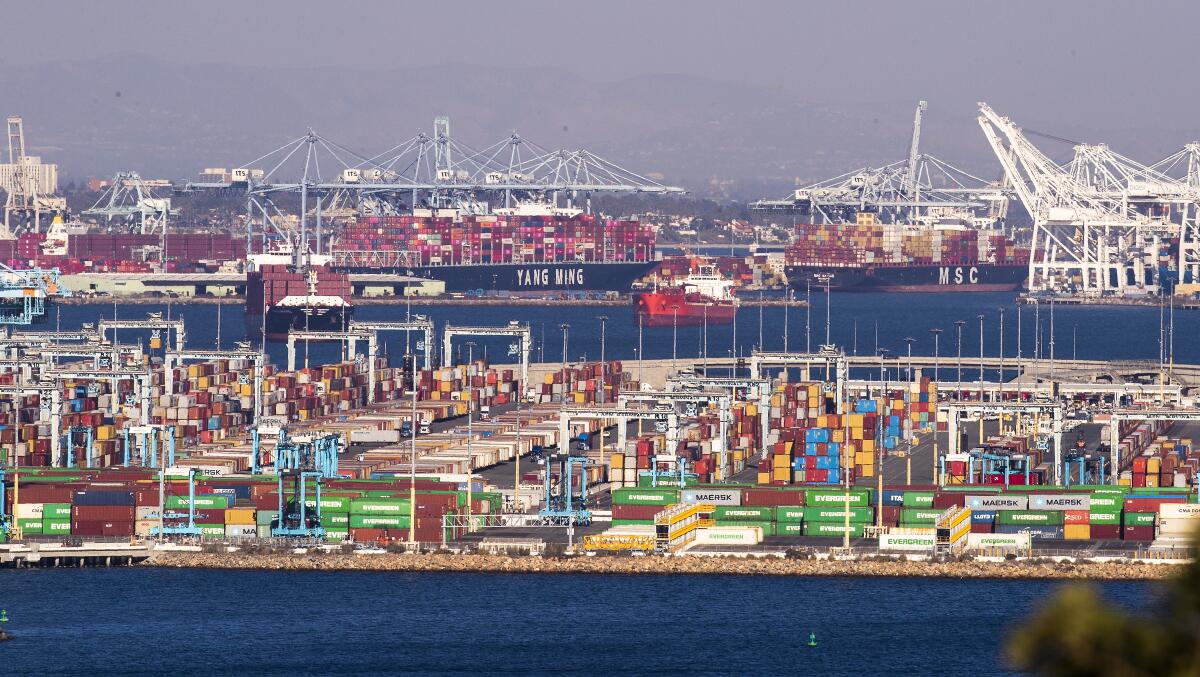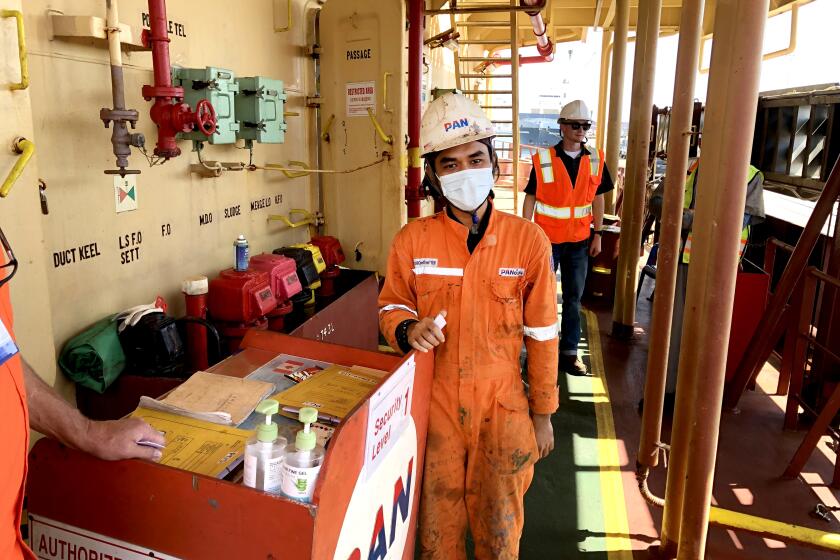The real story behind a tech founder’s ‘tweetstorm that saves Christmas’

Ryan Petersen, the founder and chief executive of the freight forwarding startup Flexport, wanted to understand the situation at the ports of Long Beach and Los Angeles. So he rented a boat last week and took a tour of the ship-and-container logjam snarling up the U.S. supply chain.
On his cruise around San Pedro Bay, Petersen got a firsthand look at the more than 70 hulking container ships idling at anchor, their $64 billion in cargo waiting to be unloaded, and the mountains of steel boxes stacked up on the docks, waiting days on end to get picked up and shipped out. He learned the docks were too crowded to accept returns of empty containers, which meant that truckers couldn’t pick up a new full container, since they were stuck with an empty one on their trailer chassis.
The following morning, Petersen tweeted this all out — and his thread became a rare viral sensation about logistics. Big thinkers from the worlds of business, politics and media shared his tweets. Coinbase Chief Executive Brian Armstrong shared it with the comment: “Bureaucracy and red tape abounds. We need to let the free market work.” Charmaine Yoest, vice president of the Heritage Foundation, asked in the thread: “Where is the leadership he calls for?” Scott Adams, Dilbert cartoonist and right-wing political commentator, added that “this sounds like the only feasible solution to the supply chain bottleneck.”
Then Gov. Gavin Newsom called him up.
“He said a bunch of people sent him my tweetstorm — he was getting hit with it left and right — so he felt obligated to get in touch,” Petersen said. He walked the governor through the thread, and explained his policy pitch.
He had tweeted five concrete recommendations: end zoning restrictions on how high containers can stack in Long Beach and Los Angeles, call in the National Guard’s spare truck chassis, make a temporary 500-acre-or-larger storage yard within 100 miles of the port, force the railroads to run shuttles to this new yard, and call on a fleet of smaller boats to clear containers off the docks.
A $5-billion infusion of federal and state loan money won’t fix the current crisis at Southern California’s crucial ports but could help them in the future.
“I let him know I’m here as a resource, I’m not an activist, I’m not trying to be a pain in his ass,” Petersen added. “I think it’s a feature that government moves slowly; you don’t want them to do rash things with taxpayer money. But it’s a problem in the middle of a crisis.”
In Long Beach itself, the message came through loud and clear. Friends had tagged Mayor Robert Garcia on the thread, and he forwarded it to his staff. By the end of the day, the city had lifted the restriction on stacking the 9-foot-tall containers only two high, and now capped it at four.
“Within a few hours we had all decided that we had to make this change immediately,” Garcia said. The relaxed rules are in effect for 90 days, and only apply to businesses that were already zoned for storing containers.
“If you are in a neighborhood, you don’t want to look out your front yard and see five- or six-stacked-high cargo containers. It is a blight and environmental justice issue, no question there,” Garcia said. But with the holiday season and piles of dockside containers looming large, he thought it was worth a shot.
Twitter took a victory lap. “The Twitter thread worked!” wrote Axios correspondent Felix Salmon. “Now we just need every city to do this with every height limitation regulation, and permanently,” wrote independent journalist Matthew Yglesias. A Bloomberg columnist predicted Petersen’s thread “could be the tweetstorm that saves Christmas.”
The impact of this shift, however, is difficult to measure. The change only applies to yards within the city of Long Beach that weren’t already zoned for higher stacking levels, which had long been in effect in the industrial zone closest to the port. More than 240,000 containers are currently waiting on the docks, with an additional 500,000-plus sitting on the ships offshore.
The chief executive of the Harbor Trucking Assn., which represents the trucking companies dealing with these issues every day, says that any little bit helps, but the measure doesn’t change all that much. For one thing, allowing the stacks to climb higher doesn’t guarantee they’ll do so.
They’ve been stuck for months on cargo ships now floating off Southern California. They’re desperate
On ships caught in the huge floating traffic jam off L.A., seafarers with scant access to vaccines have been stuck in limbo for months. Unions tell of despair and violence.
“I applaud Mayor Garcia for taking some leadership in all this, but the challenge is procuring the equipment to stack that high,” Matt Schrap said. Most yards don’t have the top loaders necessary, let alone the skilled operator and space to safely and efficiently stack containers.
The real issue, Schrap says, is just that the shipping companies won’t take their empty containers back: “The ocean carriers need to come sweep out the empties.” Adding insult to injury, the ocean carriers bill truckers a late fee every day for unreturned empty containers, Schrap said, even if they won’t accept them at the port. “It makes you want to pick up your laptop and Frisbee it out into the backyard,” Schrap said. “That’s the frustration running through our veins.”
Bruce White, who owns Three Rivers Trucking in Long Beach and does have the equipment necessary, said that he had already been stacking containers more than two high in any part of his yard not blocked by power lines, and didn’t see this change as more than a drop in the bucket.
“Let’s just take a two-acre yard. So what is that, maybe 100 containers? You stack them another level higher, so that’s a lousy 100 containers — we’re upside down by tens of thousands,” White said. He had to fill his yard with 85 empty containers at once recently when a shipping company wouldn’t accept them back at the terminal. “You multiply that by what every other trucker does down here, think about what a mess that made in just a week.”
Lisa Wan, director of operations at the trucking firm RoadEx America, said that the firm ordered a top loader specifically to be able to move and stack containers months ago — but delivery delays meant it won’t show up until next week.
“We’re lucky we’re getting it at all, so we don’t complain,” Wan said. Once that arrives, the firm will be able to stack 20 to 30 empty containers in its yard, freeing up chassis for more pickups at the ports.
She’s also seen signs of improvement at the port itself. The congestion has meant that individual terminals put out calls for specific shipping companies’ empty containers to be returned only on certain days — and during certain time slots. But if the empty return appointment is after the appointment to pick up a full container, neither can happen. A few terminals, Wan said, are finally relaxing their rules to allow all-day empty drop-off windows.
The Los Angeles City Council has not considered the option to relax the stacking limit, and Branimir Kvartuc, spokesperson for Councilman Joe Buscaino, whose 15th District covers the port area, said that his office was opposed to allowing additional stacking in the city out of concern for residents.
But other measures — not mentioned in Petersen’s thread — are going into effect. The Port of Los Angeles and Buscaino’s office are working to open 12 lots in and around the terminals that could store up to 30,000 containers, and the Port of Long Beach has already expanded its temporary storage yards to store 12,000 containers.
Local politicians are betting that a new fee on containers idling at the docks — charged to the ocean shipping companies themselves — will get some boxes moving. Starting in November, any container meant for a truck that sits at either port for more than nine days will incur a $100 fee, followed by escalating fees of $100 more each day. If a container is meant to go on a train, those fees kick in after just six days on the dock.
The idea is to spur the shipping lines to take charge of the situation and start pushing their customers to come pick up their stuff.
Despite the announcement in early October from the Biden administration that the ports would be operating 24/7, only one terminal at the Port of Long Beach has actually implemented 24-hour shifts, and only for four days a week. At the Port of Los Angeles, according to spokesperson Phillip Sanfield, 30% to 40% of pickup time slots during daylight hours are going unused as it is, so the terminals — which are operated by private companies — see no reason to open up in the middle of the night.
But the new fee doesn’t apply to empty containers. Schrap, the Harbor Trucking Assn. chief executive, said that he was baffled by the omission. The reason that pickup slots are going unused is the empty containers taking up space on the back of trucks, he said. “This fee is a shot across the bow at the ocean carriers because they need them to be engaged,” Schrap said, “but it’s mind-boggling to me that this is not being applied to empty containers.”
Petersen, for his part, said he was gratified by the response to his tweet thread, even if policymakers are finding different solutions. Although he offered in one tweet “to lead this effort for federal or state government if asked,” it would have meant walking away from his own rapidly growing logistics business: Flexport revenues are on track to hit $3.2 billion in 2021, more than double the previous year’s bookings, according to the company.
He predicts the traffic jam at the ports will take months to fully resolve. “It’s a very complex world, and I’m very suspect of everybody who has this clean narrative about how it’s all gonna play out,” he said.
White, the trucking company owner, agreed, and offered his own prescription. “People ask me what I think the answer is,” he said, “and I tell them: Move Christmas to April, because that’s when you’re gonna get your stuff.”









